Effective Communication in Nursing: CER130 Barriers and Solutions
VerifiedAdded on 2023/03/30
|6
|1032
|415
Essay
AI Summary
This essay provides a comprehensive overview of communication in a healthcare setting, specifically focusing on nursing. It addresses the difficulties in understanding patients over the phone and the importance of non-verbal cues. The essay identifies and categorizes different types of communication, including verbal, non-verbal, written, visual, formal, and informal, with examples of their application in healthcare. It also delves into the barriers to effective communication, such as poor listening skills, perceptual biases, emotional and psychological factors, linguistic differences, and physical limitations. The author reflects on a personal communication style quiz, acknowledging areas for improvement in listening and analytical skills, and proposes strategies like meditation and exercise to enhance concentration and mental strength. The essay concludes with a list of references, highlighting various sources used to support the discussion on healthcare communication.
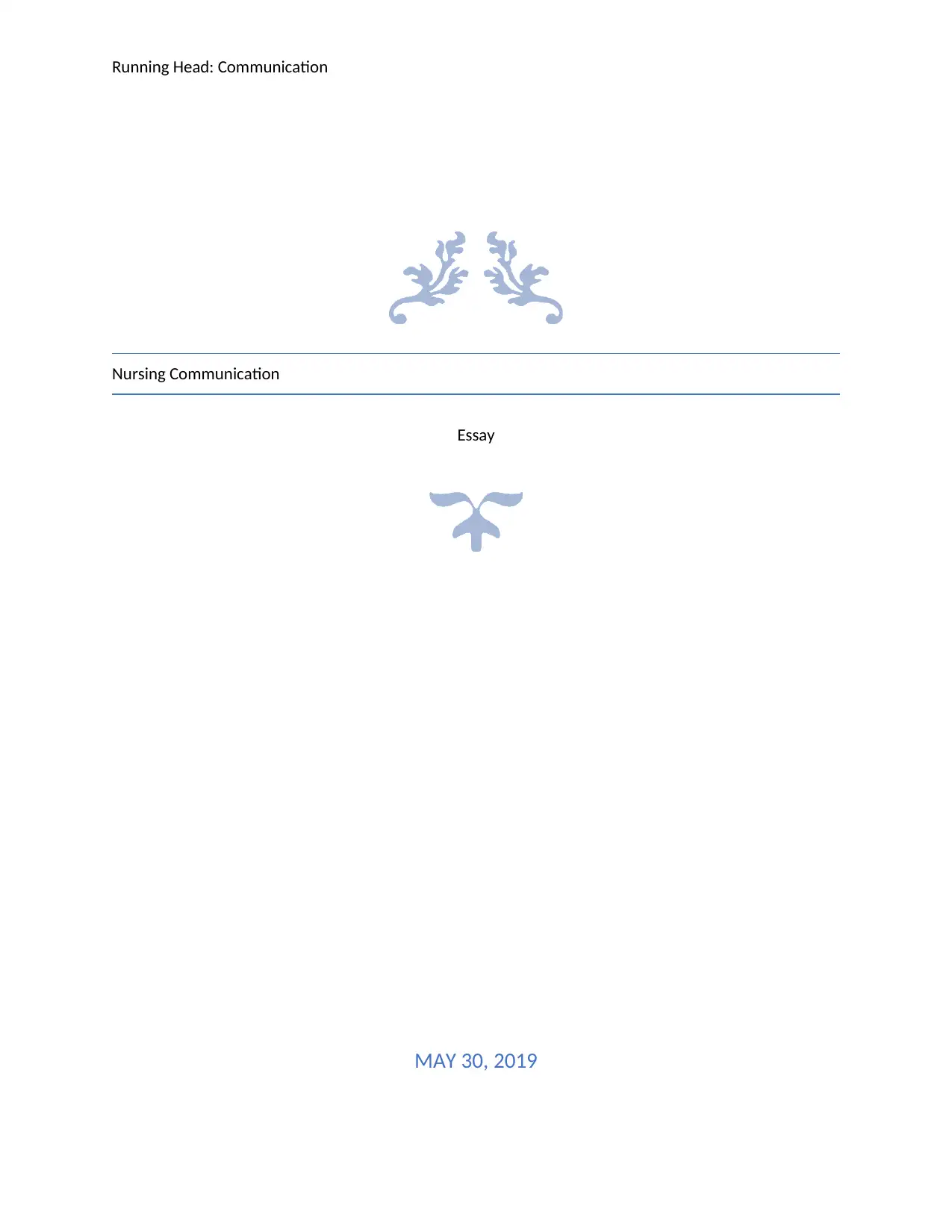
Running Head: Communication
Nursing Communication
Essay
MAY 30, 2019
Nursing Communication
Essay
MAY 30, 2019
Paraphrase This Document
Need a fresh take? Get an instant paraphrase of this document with our AI Paraphraser
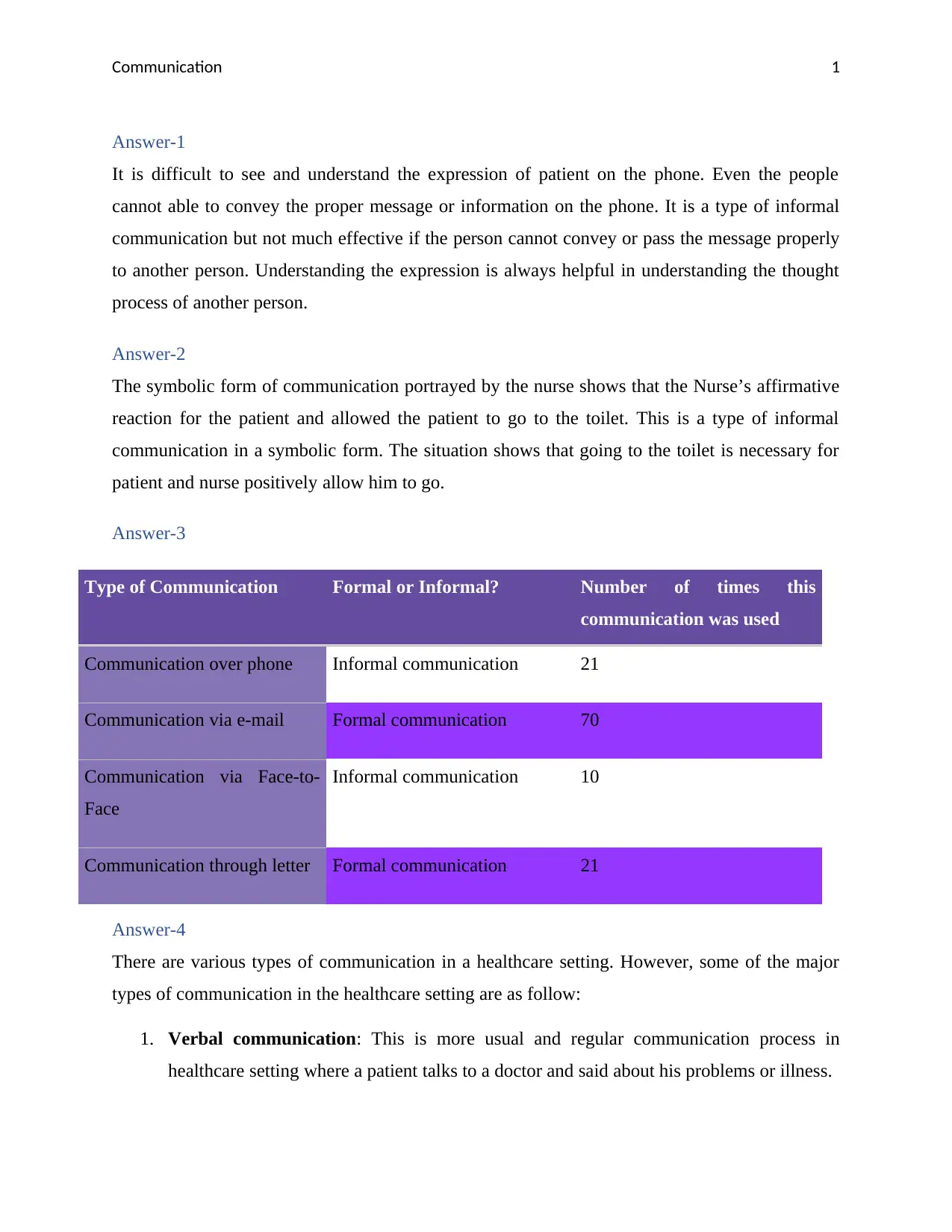
Communication 1
Answer-1
It is difficult to see and understand the expression of patient on the phone. Even the people
cannot able to convey the proper message or information on the phone. It is a type of informal
communication but not much effective if the person cannot convey or pass the message properly
to another person. Understanding the expression is always helpful in understanding the thought
process of another person.
Answer-2
The symbolic form of communication portrayed by the nurse shows that the Nurse’s affirmative
reaction for the patient and allowed the patient to go to the toilet. This is a type of informal
communication in a symbolic form. The situation shows that going to the toilet is necessary for
patient and nurse positively allow him to go.
Answer-3
Answer-4
There are various types of communication in a healthcare setting. However, some of the major
types of communication in the healthcare setting are as follow:
1. Verbal communication: This is more usual and regular communication process in
healthcare setting where a patient talks to a doctor and said about his problems or illness.
Type of Communication Formal or Informal? Number of times this
communication was used
Communication over phone Informal communication 21
Communication via e-mail Formal communication 70
Communication via Face-to-
Face
Informal communication 10
Communication through letter Formal communication 21
Answer-1
It is difficult to see and understand the expression of patient on the phone. Even the people
cannot able to convey the proper message or information on the phone. It is a type of informal
communication but not much effective if the person cannot convey or pass the message properly
to another person. Understanding the expression is always helpful in understanding the thought
process of another person.
Answer-2
The symbolic form of communication portrayed by the nurse shows that the Nurse’s affirmative
reaction for the patient and allowed the patient to go to the toilet. This is a type of informal
communication in a symbolic form. The situation shows that going to the toilet is necessary for
patient and nurse positively allow him to go.
Answer-3
Answer-4
There are various types of communication in a healthcare setting. However, some of the major
types of communication in the healthcare setting are as follow:
1. Verbal communication: This is more usual and regular communication process in
healthcare setting where a patient talks to a doctor and said about his problems or illness.
Type of Communication Formal or Informal? Number of times this
communication was used
Communication over phone Informal communication 21
Communication via e-mail Formal communication 70
Communication via Face-to-
Face
Informal communication 10
Communication through letter Formal communication 21
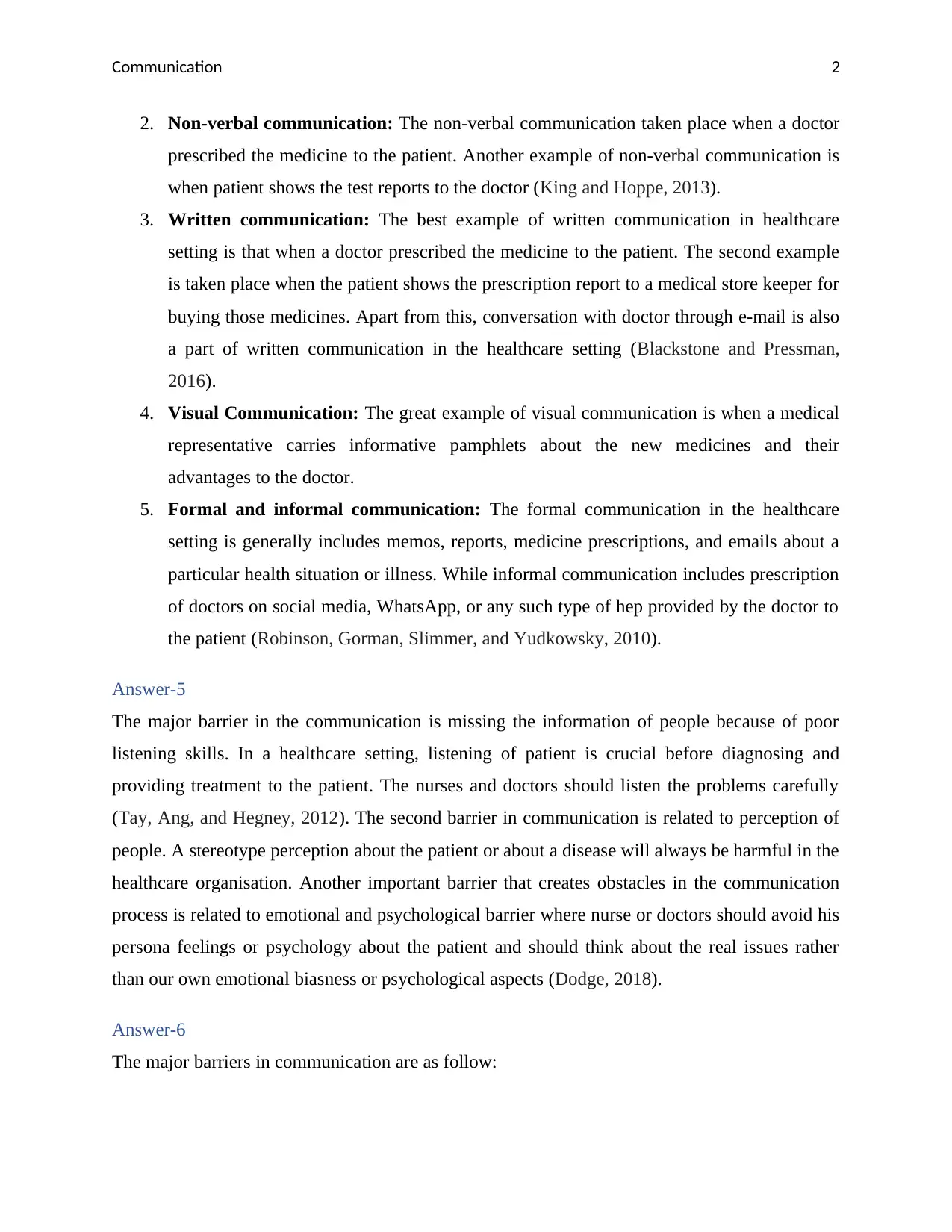
Communication 2
2. Non-verbal communication: The non-verbal communication taken place when a doctor
prescribed the medicine to the patient. Another example of non-verbal communication is
when patient shows the test reports to the doctor (King and Hoppe, 2013).
3. Written communication: The best example of written communication in healthcare
setting is that when a doctor prescribed the medicine to the patient. The second example
is taken place when the patient shows the prescription report to a medical store keeper for
buying those medicines. Apart from this, conversation with doctor through e-mail is also
a part of written communication in the healthcare setting (Blackstone and Pressman,
2016).
4. Visual Communication: The great example of visual communication is when a medical
representative carries informative pamphlets about the new medicines and their
advantages to the doctor.
5. Formal and informal communication: The formal communication in the healthcare
setting is generally includes memos, reports, medicine prescriptions, and emails about a
particular health situation or illness. While informal communication includes prescription
of doctors on social media, WhatsApp, or any such type of hep provided by the doctor to
the patient (Robinson, Gorman, Slimmer, and Yudkowsky, 2010).
Answer-5
The major barrier in the communication is missing the information of people because of poor
listening skills. In a healthcare setting, listening of patient is crucial before diagnosing and
providing treatment to the patient. The nurses and doctors should listen the problems carefully
(Tay, Ang, and Hegney, 2012). The second barrier in communication is related to perception of
people. A stereotype perception about the patient or about a disease will always be harmful in the
healthcare organisation. Another important barrier that creates obstacles in the communication
process is related to emotional and psychological barrier where nurse or doctors should avoid his
persona feelings or psychology about the patient and should think about the real issues rather
than our own emotional biasness or psychological aspects (Dodge, 2018).
Answer-6
The major barriers in communication are as follow:
2. Non-verbal communication: The non-verbal communication taken place when a doctor
prescribed the medicine to the patient. Another example of non-verbal communication is
when patient shows the test reports to the doctor (King and Hoppe, 2013).
3. Written communication: The best example of written communication in healthcare
setting is that when a doctor prescribed the medicine to the patient. The second example
is taken place when the patient shows the prescription report to a medical store keeper for
buying those medicines. Apart from this, conversation with doctor through e-mail is also
a part of written communication in the healthcare setting (Blackstone and Pressman,
2016).
4. Visual Communication: The great example of visual communication is when a medical
representative carries informative pamphlets about the new medicines and their
advantages to the doctor.
5. Formal and informal communication: The formal communication in the healthcare
setting is generally includes memos, reports, medicine prescriptions, and emails about a
particular health situation or illness. While informal communication includes prescription
of doctors on social media, WhatsApp, or any such type of hep provided by the doctor to
the patient (Robinson, Gorman, Slimmer, and Yudkowsky, 2010).
Answer-5
The major barrier in the communication is missing the information of people because of poor
listening skills. In a healthcare setting, listening of patient is crucial before diagnosing and
providing treatment to the patient. The nurses and doctors should listen the problems carefully
(Tay, Ang, and Hegney, 2012). The second barrier in communication is related to perception of
people. A stereotype perception about the patient or about a disease will always be harmful in the
healthcare organisation. Another important barrier that creates obstacles in the communication
process is related to emotional and psychological barrier where nurse or doctors should avoid his
persona feelings or psychology about the patient and should think about the real issues rather
than our own emotional biasness or psychological aspects (Dodge, 2018).
Answer-6
The major barriers in communication are as follow:
⊘ This is a preview!⊘
Do you want full access?
Subscribe today to unlock all pages.

Trusted by 1+ million students worldwide
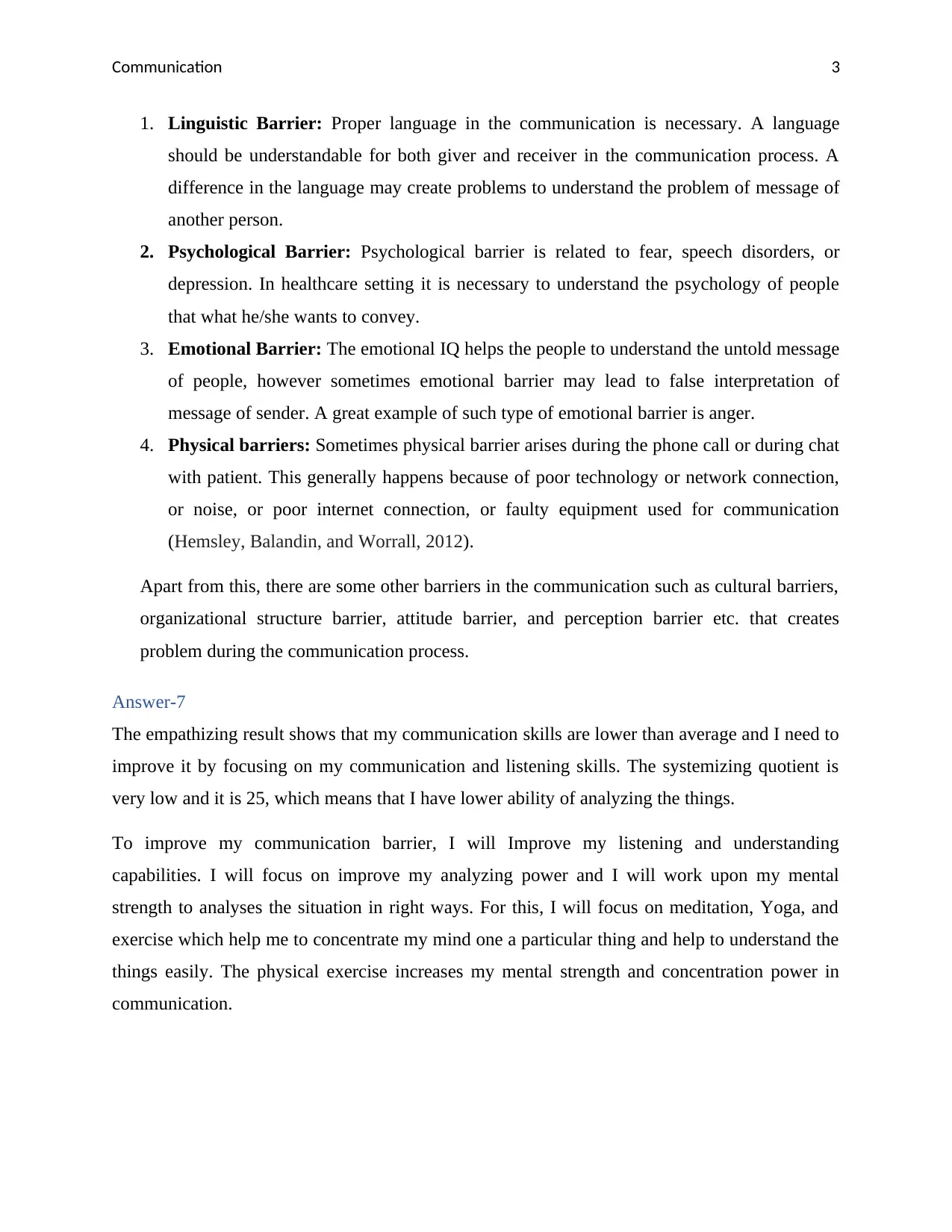
Communication 3
1. Linguistic Barrier: Proper language in the communication is necessary. A language
should be understandable for both giver and receiver in the communication process. A
difference in the language may create problems to understand the problem of message of
another person.
2. Psychological Barrier: Psychological barrier is related to fear, speech disorders, or
depression. In healthcare setting it is necessary to understand the psychology of people
that what he/she wants to convey.
3. Emotional Barrier: The emotional IQ helps the people to understand the untold message
of people, however sometimes emotional barrier may lead to false interpretation of
message of sender. A great example of such type of emotional barrier is anger.
4. Physical barriers: Sometimes physical barrier arises during the phone call or during chat
with patient. This generally happens because of poor technology or network connection,
or noise, or poor internet connection, or faulty equipment used for communication
(Hemsley, Balandin, and Worrall, 2012).
Apart from this, there are some other barriers in the communication such as cultural barriers,
organizational structure barrier, attitude barrier, and perception barrier etc. that creates
problem during the communication process.
Answer-7
The empathizing result shows that my communication skills are lower than average and I need to
improve it by focusing on my communication and listening skills. The systemizing quotient is
very low and it is 25, which means that I have lower ability of analyzing the things.
To improve my communication barrier, I will Improve my listening and understanding
capabilities. I will focus on improve my analyzing power and I will work upon my mental
strength to analyses the situation in right ways. For this, I will focus on meditation, Yoga, and
exercise which help me to concentrate my mind one a particular thing and help to understand the
things easily. The physical exercise increases my mental strength and concentration power in
communication.
1. Linguistic Barrier: Proper language in the communication is necessary. A language
should be understandable for both giver and receiver in the communication process. A
difference in the language may create problems to understand the problem of message of
another person.
2. Psychological Barrier: Psychological barrier is related to fear, speech disorders, or
depression. In healthcare setting it is necessary to understand the psychology of people
that what he/she wants to convey.
3. Emotional Barrier: The emotional IQ helps the people to understand the untold message
of people, however sometimes emotional barrier may lead to false interpretation of
message of sender. A great example of such type of emotional barrier is anger.
4. Physical barriers: Sometimes physical barrier arises during the phone call or during chat
with patient. This generally happens because of poor technology or network connection,
or noise, or poor internet connection, or faulty equipment used for communication
(Hemsley, Balandin, and Worrall, 2012).
Apart from this, there are some other barriers in the communication such as cultural barriers,
organizational structure barrier, attitude barrier, and perception barrier etc. that creates
problem during the communication process.
Answer-7
The empathizing result shows that my communication skills are lower than average and I need to
improve it by focusing on my communication and listening skills. The systemizing quotient is
very low and it is 25, which means that I have lower ability of analyzing the things.
To improve my communication barrier, I will Improve my listening and understanding
capabilities. I will focus on improve my analyzing power and I will work upon my mental
strength to analyses the situation in right ways. For this, I will focus on meditation, Yoga, and
exercise which help me to concentrate my mind one a particular thing and help to understand the
things easily. The physical exercise increases my mental strength and concentration power in
communication.
Paraphrase This Document
Need a fresh take? Get an instant paraphrase of this document with our AI Paraphraser
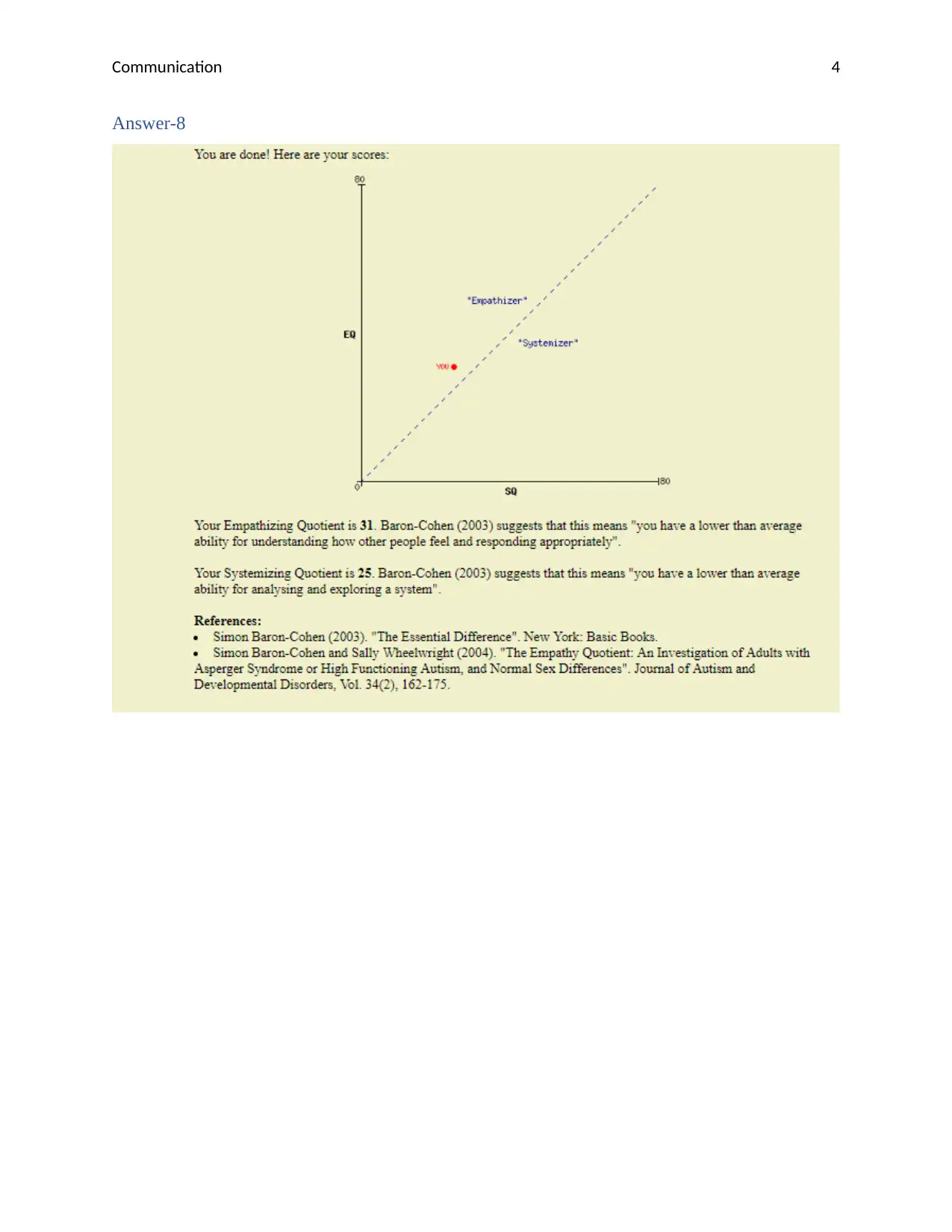
Communication 4
Answer-8
Answer-8
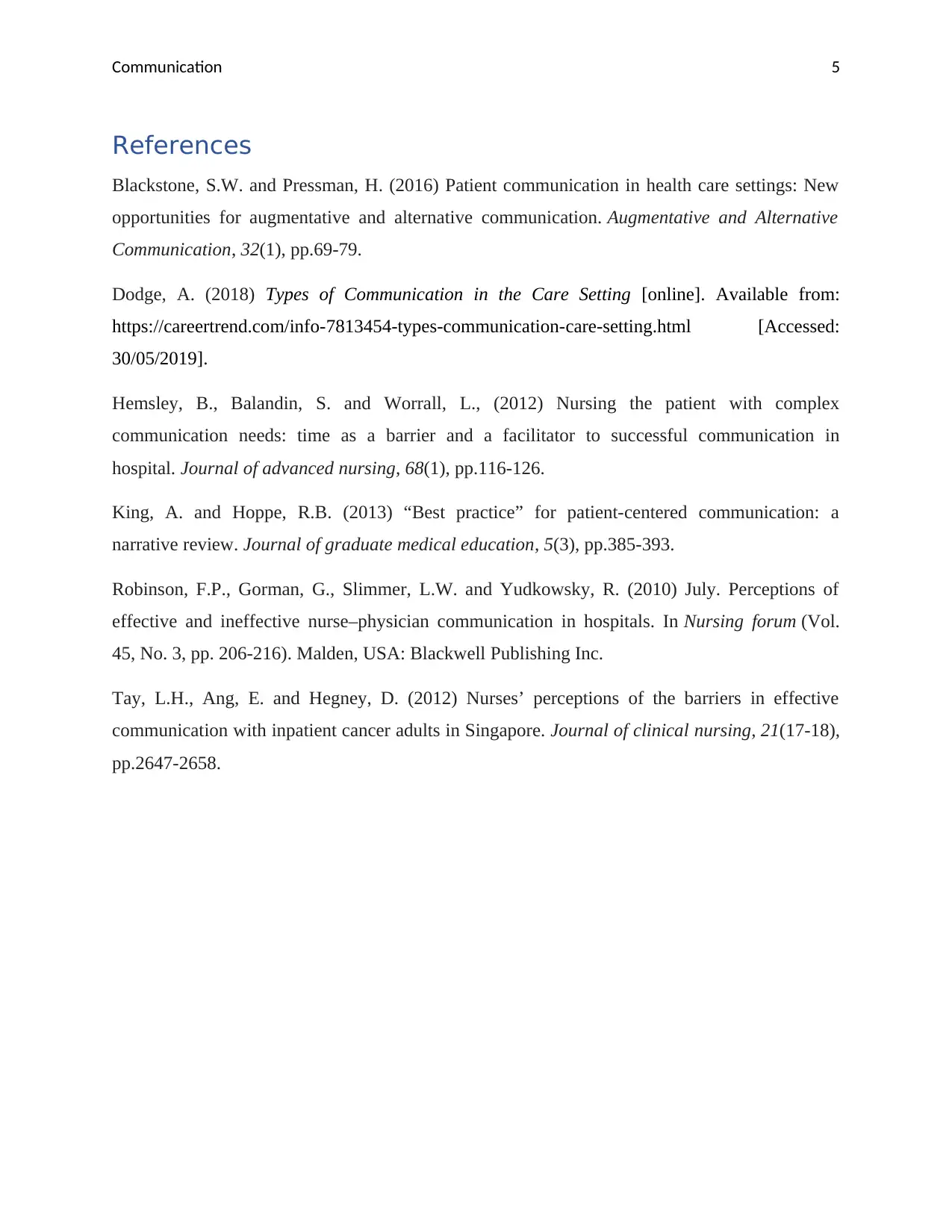
Communication 5
References
Blackstone, S.W. and Pressman, H. (2016) Patient communication in health care settings: New
opportunities for augmentative and alternative communication. Augmentative and Alternative
Communication, 32(1), pp.69-79.
Dodge, A. (2018) Types of Communication in the Care Setting [online]. Available from:
https://careertrend.com/info-7813454-types-communication-care-setting.html [Accessed:
30/05/2019].
Hemsley, B., Balandin, S. and Worrall, L., (2012) Nursing the patient with complex
communication needs: time as a barrier and a facilitator to successful communication in
hospital. Journal of advanced nursing, 68(1), pp.116-126.
King, A. and Hoppe, R.B. (2013) “Best practice” for patient-centered communication: a
narrative review. Journal of graduate medical education, 5(3), pp.385-393.
Robinson, F.P., Gorman, G., Slimmer, L.W. and Yudkowsky, R. (2010) July. Perceptions of
effective and ineffective nurse–physician communication in hospitals. In Nursing forum (Vol.
45, No. 3, pp. 206-216). Malden, USA: Blackwell Publishing Inc.
Tay, L.H., Ang, E. and Hegney, D. (2012) Nurses’ perceptions of the barriers in effective
communication with inpatient cancer adults in Singapore. Journal of clinical nursing, 21(17‐18),
pp.2647-2658.
References
Blackstone, S.W. and Pressman, H. (2016) Patient communication in health care settings: New
opportunities for augmentative and alternative communication. Augmentative and Alternative
Communication, 32(1), pp.69-79.
Dodge, A. (2018) Types of Communication in the Care Setting [online]. Available from:
https://careertrend.com/info-7813454-types-communication-care-setting.html [Accessed:
30/05/2019].
Hemsley, B., Balandin, S. and Worrall, L., (2012) Nursing the patient with complex
communication needs: time as a barrier and a facilitator to successful communication in
hospital. Journal of advanced nursing, 68(1), pp.116-126.
King, A. and Hoppe, R.B. (2013) “Best practice” for patient-centered communication: a
narrative review. Journal of graduate medical education, 5(3), pp.385-393.
Robinson, F.P., Gorman, G., Slimmer, L.W. and Yudkowsky, R. (2010) July. Perceptions of
effective and ineffective nurse–physician communication in hospitals. In Nursing forum (Vol.
45, No. 3, pp. 206-216). Malden, USA: Blackwell Publishing Inc.
Tay, L.H., Ang, E. and Hegney, D. (2012) Nurses’ perceptions of the barriers in effective
communication with inpatient cancer adults in Singapore. Journal of clinical nursing, 21(17‐18),
pp.2647-2658.
⊘ This is a preview!⊘
Do you want full access?
Subscribe today to unlock all pages.

Trusted by 1+ million students worldwide
1 out of 6
Related Documents
Your All-in-One AI-Powered Toolkit for Academic Success.
+13062052269
info@desklib.com
Available 24*7 on WhatsApp / Email
![[object Object]](/_next/static/media/star-bottom.7253800d.svg)
Unlock your academic potential
Copyright © 2020–2025 A2Z Services. All Rights Reserved. Developed and managed by ZUCOL.



